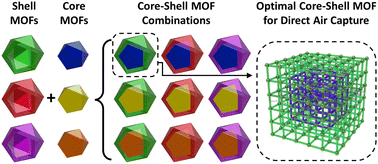Phys.org October 11, 2022
MOFs utilize porous membranes to capture large volumes of gasses and can be designed via computational modeling rather than traditional trial-and-error. However, adsorbents designed to strongly bind CO2 nearly always bind H2O strongly. A team of researchers in the US (University of Pittsburgh, DOE) has a direct air capture (DAC) strategy to remove carbon dioxide from the air using core–shell MOF design, where a high-CO2-capacity MOF “core” is protected from competitive H2O-binding via a MOF “shell” that has very slow water diffusion. They considered a high-frequency adsorption/desorption cycle that regenerates the adsorbents before water can pass through the shell and enter the core. To identify optimal core–shell MOF pairs, they used a combination of experimental measurements, computational modeling, and multiphysics modeling. Their library of MOFs was created from two starting MOFs-UiO-66 and UiO-67-augmented with 30 possible functional group variations, yielding 1740 possible core–shell MOF pairs. After defining a performance score to rank these pairs, they identified 10 core–shell MOF candidates that significantly outperform any of the MOFs functioning alone…read more. TECHNICAL ARTICLE

Graphical abstract. Credit: Nanoscale, 2022, Advance Article